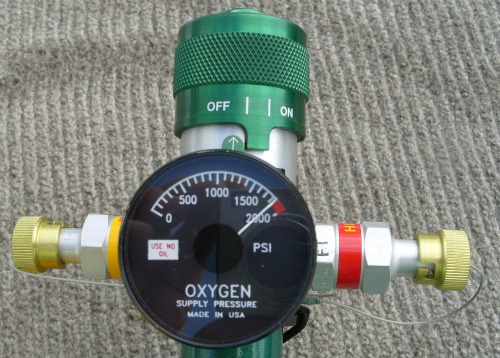First Aid Oxygen
 Saturday, September 10, 2011 at 7:42AM
Saturday, September 10, 2011 at 7:42AM We have all seen the First Aid Oxygen bottles on our aircraft, but what are they actually there for? First Aid! Obviously! However, EU Ops does cover their requirement under OPS 1.760 where it states that “an operator shall not operate a pressurised aeroplane at altitudes above 25 000 ft, when a cabin crew member is required to be carried, unless it is equipped with a supply of undiluted oxygen for passengers who, for physiological reasons, might require oxygen following a cabin depressurisation.”
The amount of oxygen to be carried has to allow a flow rate of 3 litres per minute, per person for the remainder of the flight after a depressurisation (cabin altitude 8000’-15000’) for at least one person (in a business jet), with two dispensing units, which maybe of a portable type. How much oxygen is required for a particular operation shall be determined on the basis of cabin pressure altitudes and flight duration. The equipment shall be capable of generating an oxygen flow of 4 litres per minute, with a minimum of 2 litres per minute at any altitude.
So, that is the law. But how does it work in actual operations. As an example, I will look at the types of First Aid Oxygen available in my own company. We have First Aid Oxygen available on all our aircraft, even the ones without a cabin crew member which is not required according to EU Ops. We also have several first aid oxygen options available.
AVOX Systems 5600 Series
The manufacturer says the 5600 Series Portable Oxygen System is a self-contained breathing system offering demand, pressure-demand and constant flow capabilities. It provides high efficiency supplementary oxygen and respiratory protection for aviation use. The constant flow operation provides high altitude supplementary oxygen for up to two passengers or crew when needed.
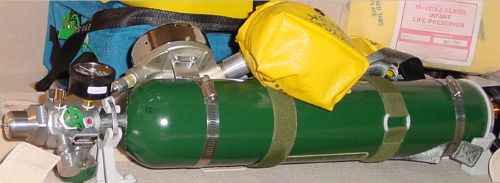 Here is a picture of the bottle showing it stowed in its proper location. The big silver regulator you can see on the top of the picture need not be there as this is only used to connect the Full Face Smoke Mask to the bottle. For First Aid purposes, you only need the two valves at the top of the bottle, as shown in the next picture which shows the valves and the pressure gauge (which indicates EMPTY).
Here is a picture of the bottle showing it stowed in its proper location. The big silver regulator you can see on the top of the picture need not be there as this is only used to connect the Full Face Smoke Mask to the bottle. For First Aid purposes, you only need the two valves at the top of the bottle, as shown in the next picture which shows the valves and the pressure gauge (which indicates EMPTY).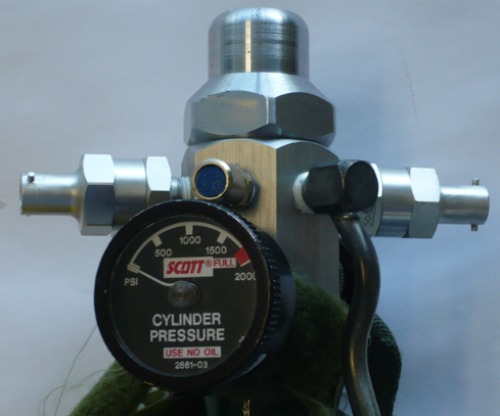
When carrying out your pre-flight checks on the bottle, ensure that the bottle is full by checking the gauge. Also check that you have 2 masks available in the yellow pouch.
Using the AVOX 5600
Remove the bottle from its stored location and take it to your patient. Take a mask from the yellow pouch on the side of the bottle and attach the mask hose to either of the bottle valves using the bayonet type fitting. Turn on the oxygen before fitting the mask to the patient.
PURITAN BENNET 120 litre Portable Bottle
The other portable bottle in use by my company is the Puritan Bennet type. This is a 120 litre bottle - a smaller one to fit into the smaller Bizjets (commonly used on the Hawkers).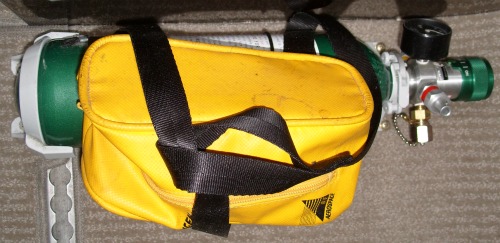
This smaller bottle is very well marked with all the things you need to know. It clearly shows when the bottle has been turned on or off and has clearly marked High (4 litres a minute) and Low (2 litres per minute) flow valves.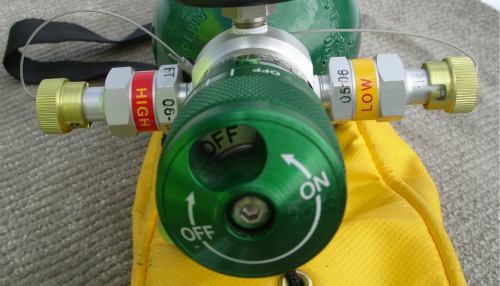 As you can see, there is no mistaking what you have to do with this bottle! The next photo shows another view of the valve assemby, this time showing the pressure guage.
As you can see, there is no mistaking what you have to do with this bottle! The next photo shows another view of the valve assemby, this time showing the pressure guage.